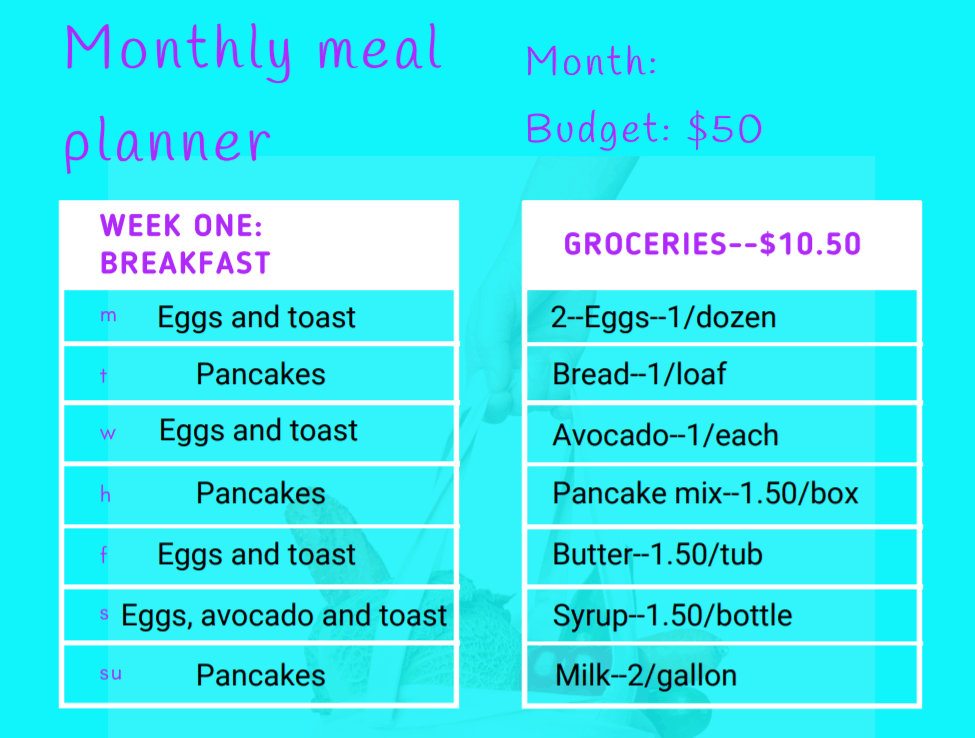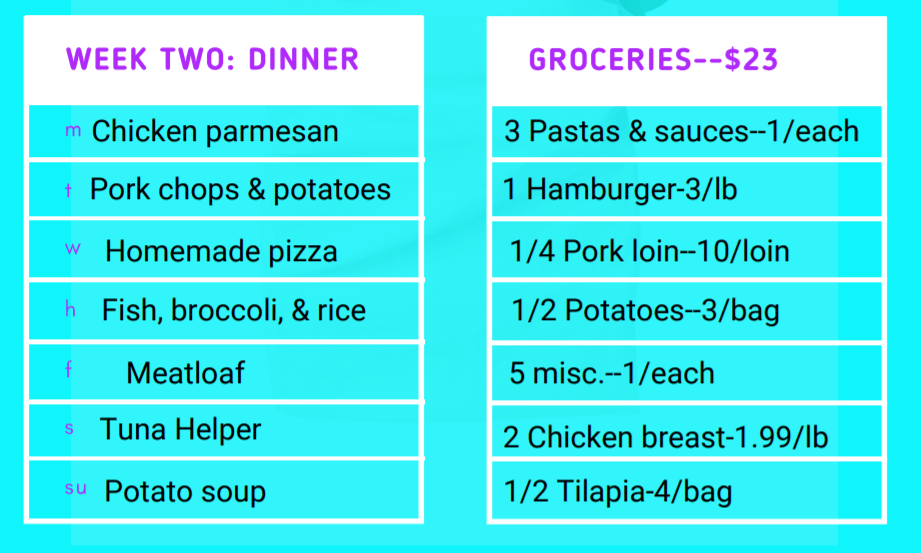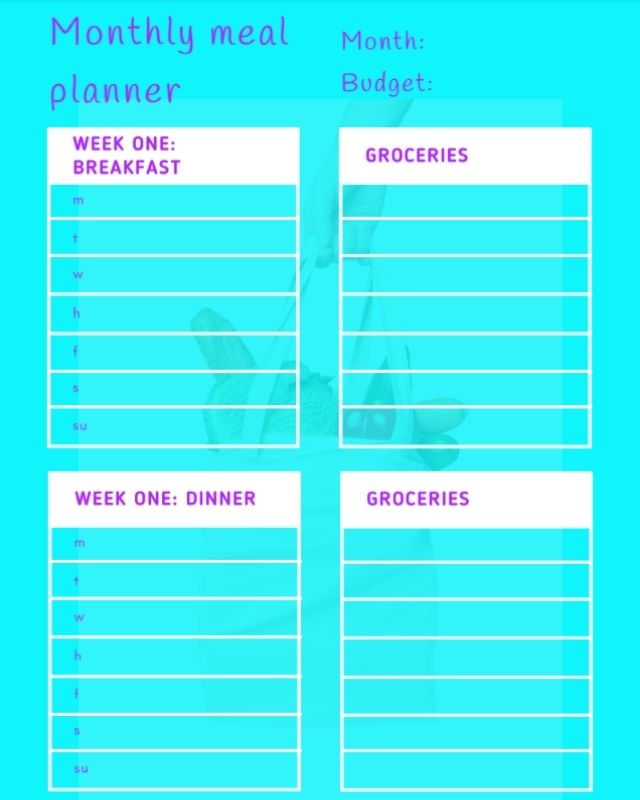Groceries are expensive and seem to get more and more costly all the time. But we have to eat.

Despite the increase in prices, it’s still possible to feed 2 people on $50 a week.
Contents
$50 Meal Plan For Two and a Grocery List
In order to make this plan work, two people are essentially eating two meals on a little more than $7/day.
This plan also factors in sales on certain items and only drinking water.
Keep in mind that Indiana prices are often cheaper than other areas with bigger cities.
Breakfast:
- Eggs and toast (4 days)
- Pancakes (3 days)
- Eggs, avocado, and toast (1 day)
It might look something like this:

Dinner:
- Spaghetti
- Pork loin and potatoes
- Chicken and rice
- Alfredo
- Fish and rice
- Hamburger Helper
- Chili
Any of those meals could be repeated in other weeks and often used for lunches. (Spaghetti and Chili go a long way!)
It might look like this:

The total on this week is only $38, which leaves room for spices, fruits, and vegetables.
It also factors in items that do not have to be purchased in other weeks (pancake mix, syrup, butter, pork loin, potatoes, and tilapia).
If any items were on sale, they could be bought in bulk (with the extra money) and saved.
Just in case you think it’s a fluke week, here’s another (more robust) example.
Breakfast:
- Eggs and toast (2 days)
- Eggs, toast, and sausage (1 day)
- Pancakes (2 days)
- Cereal (1 day)
- Waffle with fruit (1 day)
It might look something like this:

Dinner:
- Chicken parmesan
- Fish, broccoli, and rice
- Tuna Helper
- Meatloaf
- Pork chops with potatoes
- Potato soup
- Homemade pizza
It might look like this:

With this plan, breakfast cost a bit more at $13.50, but dinner is cheaper at only $23 for a total of $36.50.
With the leftover funds, you can purchase something special to drink (besides water or milk), or you can spice up your existing meals.
Add garlic bread to your chicken parmesan, potatoes to your meatloaf, or fancy toppings for your homemade pizza.
If you need any help here’s our cheapest grocery list.
How to feed 2 people on 50 dollars a week
First, it’s important to understand how to save money on groceries. There are five methods that we’ll highlight.
- Grow your own
- Barter
- Find deals/sales
- Venture into expiring shelf-life
- Coupon
Grow your own
You don’t need a ton of space or experience to grow your own groceries, but you do need some patience. Herbs are incredibly easy to grow from home. Tomatoes are also fairly easy to grow at home. If you have a larger space, a garden is ideal. Seeds cost next to nothing, and you can often get starters for free.
Barter
If you’re not ready to grow your own groceries, you can consider bartering for food. Bartering is one of the best ways to trade resources. Let’s say that you have a skill for woodworking.
You can barter something you created with someone who makes bread or who raises livestock.
Find deals/sales
Finding deals or sales are another great way to save money.
In order to do this, it may mean you have to go to a few stores for the best deal, so you have to consider the actual benefit.
It also means you might have to stock up when an item is on sale.
Venture into expiring shelf-life
You can also stock up on items whose shelf life might be expiring soon.
If you stock up on those items, you have to use them quickly or preserve them in some way.
Often, you can find meat that expires soon with a coupon or reduction. You can bring that home and freeze it.
Coupons
Coupons are an essential way to save money. Coupons can be digital or printed coupons.
Our Saturday or Sunday paper has coupons.
If your newspaper is $2, but you get two $1 coupons, you’ve already paid for that $2 that you spent.
If you have a good support system, consider starting a coupon swap where you and others gather and swap coupons.
Basically, you clip and gather all the coupons you can access (and divide them into categories) before meeting up with others who have done the same. You divide them up as a whole group and then split them up.

How to shop and avoid waste
The second part of this process is knowing how to shop and how to avoid wasting food. You have to start with our free budget and a meal planner.

A budget is essential for successful planning and for staying on track. It doesn’t need to be anything fancy, but it needs to be effective. You may also need to play around with formats and budget restrictions here and there.
To start your reduction, consider starting closer to what you currently spend and reducing each month until you’re down to $50/week.
Your choices continue with frequency and how to shop. You can purchase food daily (wasteful), weekly, or monthly. Personally, I like to shop monthly and then maybe grab a few items (often with a shorter shelf life) as needed.
You also need to decide on your shopping strategy. Food delivery is expensive and often results in mistakes, so ordering pickup from the store or going to the store are better options.
As an impulse buyer, I avoid the store and order online. If you know that you’re an impulse buyer, order online to pick up.
Most grocery stores have waived fees for now, but you can also get coupons or just add the $5 charge to your budget.
If you know that you can avoid impulses and decide to go into the store, use cash for your purchases to make sure you do not go over.
Once you have your strategy set up, make sure you are ready to clean and prepare groceries to extend their life.
Fruits and vegetables
Fresh fruits and vegetables should be cleaned immediately when you get home.
There are tons of food cleaners, but water usually does the trick. It’s important to store these items correctly to maximize their life.
You can keep them in their original packaging, which is often made to allow that food to save as long as possible.
A few tips:
- Separate fruits from vegetables
- Ripen fruits on the counter before storing them in the refrigerator
- Refrigerated fruits once ripe in a container or bag with holes (eliminate moisture) to extend their life
- Freeze whatever fruits and vegetables you will not use within a week to maintain their life
- Keep greens (broccoli and lettuce) stored in the refrigerator after cleaning separating with a paper towel (to avoid slime)
- Keep root vegetables (potatoes, onions, sweet potatoes) in a cool, dark spot
Meats
Storing meat means using freezer-safe baggies and labeling the meat.
I like to clean the packaging and store the label with the meat.
You could leave the meat on the bottom shelf of the refrigerator, but if you’re looking to preserve it, make sure it’s done correctly.
Thawing doesn’t take that much time to do it safely.
Plan it out
No matter what budget you’re trying to stick to, it’s important to plan it out. Planning is the strongest way to stay on track. Take advantage of sales and opportunities as often as possible.
And if you have a chance to barter, try to find someone with those high-ticket items (like meat). You can even offer to cook for a friend or family member who buys the food. That’s a great way to reduce your food cost and enjoy others in your life.
Check out our 20 Dirt-Cheap Meals and Recipes.

Martha Warner is a writer, editor, and educator. As a single mom for many years, Martha knows the value of money, how to work hard, and how to hustle. Her freelance career started as a side hustle (to support her love of travel) and quickly grew into the most lucrative career she’s ever had. Martha still teaches at the university as well as other online and in-person courses, including Writing to Make Money, College Scholarship Writing, and Write that Grant. Find out more about her on her website.

A lot of good useful information in this article!!
Thank you, Amanda!